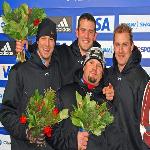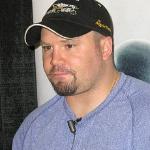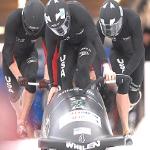06 January 2010

Photo: Amanda Bird
Steve Holcomb, bottom center, with bobsled crew members on the trophy stand
American bobsled driver Steve Holcomb knows what it is to be a champion. He and his crew took the four-man World Championship last February in Lake Placid, New York. But Holcomb almost lost his chance at Olympic success to a congenital eye disease. A revolutionary operation has given Holcomb the chance to compete in Vancouver and see the world in a whole new way.
Steve Holcomb is a quiet, unassuming man with a powerful build and a laid back demeanor. But his reserve hides a fierce competitor. The Park City, Utah native calls himself a thrill seeker at heart who competed in downhill skiing and was an alternate for the 1998 and 2002 U.S. Ski teams. His experience on the slopes taught him how to make the fastest trip downhill. Holcomb would later employ that knowledge in the men's bobsled.
Because bobsled is expensive, Holcomb joined the Utah National Guard in 1999. He was part of the U.S. Army's World Class Athlete Program for seven years, and credits the program with allowing him to compete.

VOA - D. Byrd
Steve HolcombThe Army's investment paid off. Between 2002 and 2007, Holcomb rose through the ranks to become the top U.S. bobsled driver. He placed sixth in the two-man event at the 2006 Olympics, which made him the top U.S. driver at the Turin Winter Games. He finished atop the World Cup two-man standings in 2007. He was second in the 2007 World Cup in the four-man bobsled. But later that year, his Olympic prospects literally began to dim.
Holcomb suffers from a degenerative eye condition called keratoconus which distorts vision by changing the shape of the cornea. Holcomb had tried Lasik surgery, but it only aggravated the condition. By 2007, his vision had deteriorated to 20/500. A cornea transplant would make his eyes too fragile for bobsledding. Holcomb decided that retirement was his only option.
But U.S. coach Brian Shimer - a five-time Olympian and a 2002 bronze medalist - did not want to lose Holcomb. Shimer consulted with a former bobsledder turned doctor Scott Stoll, who told him about an operation that would save Holcomb's vision. Part of the procedure is still experimental, but Holcomb told VOA Sports he knew he had to take the risk.
"At the time I really didn't have any options," he said. "It was either retire and go blind, or have this procedure and either go blind or have my eyes saved and continue my career. So I ended up getting lucky and it works fabulous, and I see 20/20 right now. I had the surgery in March of 2008 and a year later I won the World Championships."
Dr. Brian Boxer Wachler of Beverly Hills pioneered and performed the surgery. The ophthalmologist told VOA that there were two stages to Holcomb's operation - one of which involved putting a contact lens behind the irises of his eyes.
"Keratoconus is essentially like having a hernia, but instead of being in the groin it is on the cornea lens that you look through," he explained. "We stabilized it with the C-3-R vitamin light treatment that we do. And then Steve came back three months later and that's when we did these revolutionary contact lens implants called the Vision ICL, and that's what really restored his vision so that he does not have to wear any lenses at all now."
Because the operation lacks U.S. Food and Drug Administration approval, Holcomb's health insurance would not pay its $15,000 cost. Steve Holcomb almost turned it down because of the expense. But the U.S. Olympic Committee and the U.S. Bobsled Federation donated to his operation and he underwent the surgery.
The effect on Steve Holcomb's vision was immediate. He went from not being able to read the largest letter on a standard eye chart to what he calls life in high definition.

Charlie Booker
US Men's bobsled team during competitionBut his new-found sight also affected his bobsled driving. Holcomb had learned to drive by the feel of the track instead of sight because of his vision problem. Now with clear vision, he is sometimes distracted by things he could never see before. Ironically, Steve Holcomb has scratched the visor on his helmet to avoid relying too much on his eyes.
"And this year, I just threw in [added in] the vision all of a sudden and it really threw me off. And I have my helmet here and it's all scratched up and the visor's not clear. But I have to almost take away the eyes a little bit, it's too much. There's too much information I don't need, and I have to get back to the way that I learned how to drive, so it's been pretty difficult," he said.
Holcomb's teammate Steve Mesler says that he did not know about the driver's vision problems, when he first joined the squad. Mesler told VOA Sports he's glad Holcomb can see well, but is also happy the driver has gone back to "driving with his butt."
"It actually makes me feel more confident in bad weather situations," he said. "If it's snowing, as it did last year. Last year in Altenburg it snowed, it was like a blizzard. And he took it down the track and I think we went eight-10ths of a second faster on our second run when the weather was terrible. Now that his eyes are fixed, he says he tries not to react to what he sees. I guess he's got the best of both worlds now - learn how to drive blind and now he can see."
Whether driving by feel or vision, Holcomb and his team won the World Championship in 2009 in Lake Placid, New York. Holcomb and his team of Justin Olsen, Steve Mesler and Curt Tomasevicz beat Germany's No. 2 sled driven by Andre Lange - who had won the world title five of the previous seven years - by nearly one second.
It was the first time in 50 years a U.S. team won the four-man world championship. The USA has not won Olympic gold in four-man bobsled since 1948. Steve Holcomb now has his sled - and his new-found sight - set on ending that drought in Vancouver.